Today, March 8, 2024, is International Women’s Day, first celebrated in 1975. March was designated Women’s History Month in 1987. The first book on women called De Claris Mulieribus (Concerning Famous Women) was written by Giovanni Boccaccio (1313-1375), writer and poet of Florence, Italy. Beginning with Eve, Boccaccio wrote, “Since I am going to write about the glories for which women have become famous, it will not seem inappropriate to begin with Eve, who was the mother of us all.” Boccaccio named 160 women who were born before his time and whose achievements he considered significant but had been generally forgotten. The book was immediately popular, and it was widely copied and illustrated in Europe over the centuries.
Boccaccio wrote about women from mythology as well as historical figures. Many were women of Roman descent, and queens such as Cleopatra of Egypt, Semiramis of Assyria, and Empress Irene of Constantinople. He included bad women if they were notorious. He wrote the book during the summer of 1361 through 1362, and he revised it until 1375.
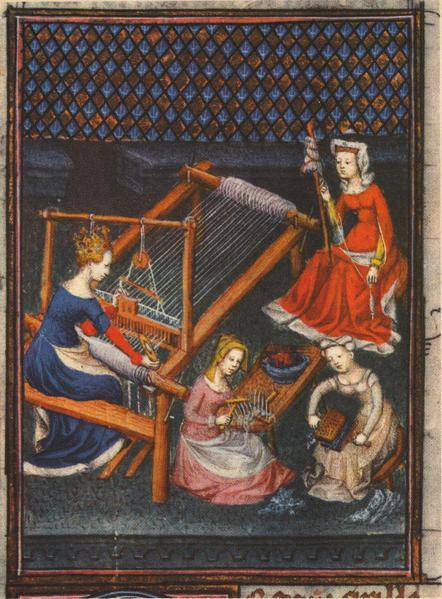
“Gaia Cyrilla Weaving” (1374)
Gaia Cyrill was the wife of Tarquinius Priscus, the 5th King of Rome, who reigned from 616-578 BCE. He was a good king, and he was responsible for building the Circus Maximus and the Cloaca Maxima, the sewer that stopped the flooding of Rome. Gaia Cyrilla was a significant factor in his successful reign. Boccaccio wrote, “Since this woman had an excellent mind, she did not allow herself to languish idly, in spite of the fact that she was the wife of a king and dwelled in a royal palace. In fact, she dedicated herself to the art of working in wool, which I believe was an honorable occupation.” Roman author Pliny the Elder, 23-79 CE, reported that a bronze statue of Gaia Cyrilla stood in the Temple of Sancus. Displayed with it were a purple tunic she wove for her son Servius Tullius, the 6th King of Rome, and a belt on which Gaia had woven healing charms that were said to have worked miracles.
“Gaia Cyrilla Weaving” (1374) (illuminated manuscript) depicts the steps for making sheep’s wool into cloth. Gaia Cyrilla is dressed in a blue gown trimmed with ermine, and she wears a jeweled crown. She sits at a large loom that is placed prominently in the composition. Next to her, two women sit on the ground and prepare the wool by combing and carding it. Behind them, a noble woman wearing a red dress with ermine trim and seated on a stool, holds a spindle and is winding the wool into thread. The spindle was called a distaff, and it was associated with “women’s work.” Women frequently were referred to as the distaff part of the family. The term is now considered to be derogatory.
This edition of Concerning Famous Women was commissioned as a gift for Philip the Bold, Duke of Burgundy, by the Italian merchant Jacques Rapondi. His wealth came from the sale of Italian cloth to northern European nobles.
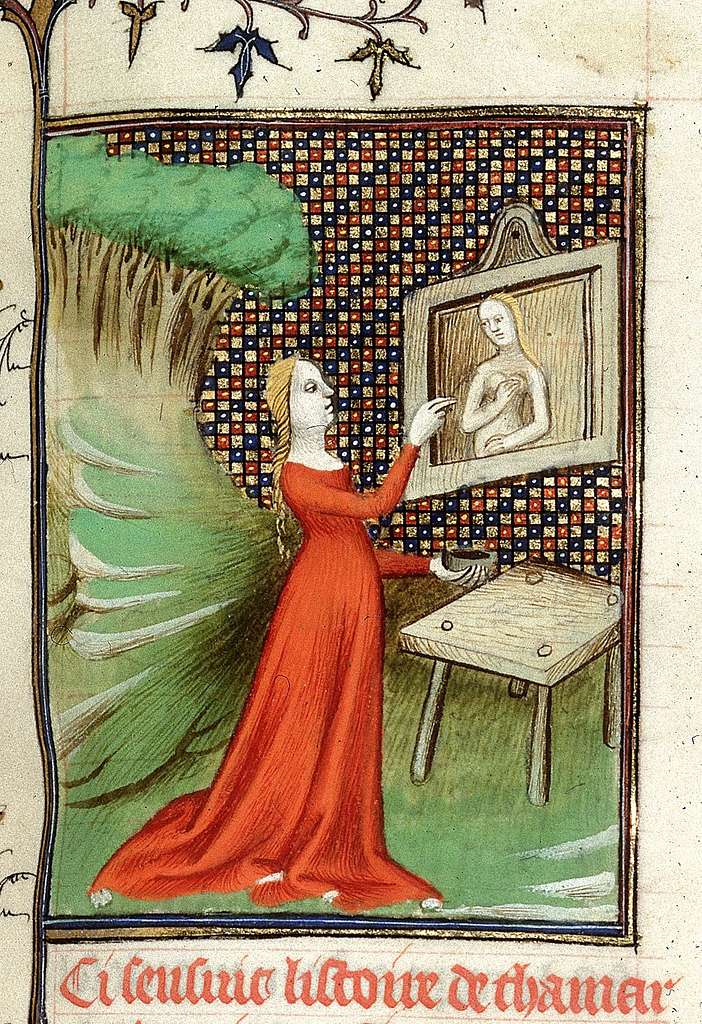
“Thamryis Painting” (1400-1425)
Thamryis was the daughter of the painter Micon the younger, and she was according to Boccaccio “a fine painter. Although time may have lessened her excellence, it has not yet been able to destroy her fame and her skill.” He also wrote that “Thamryis scorned womanly tasks and practiced her father’s craft with remarkable talent. When Archelaus was king of Macedonia, she gained such acclaim for her painting that the Ephesians, who had a particular veneration for Diana, long preserved as a celebrated image of this goddess a panel painting done by Thamryis.” In this illumination by an unknown French painter, Thamryis is depicted painting the Goddess Diana. Pliny wrote that the painting was displayed in the temple of Ephesus until it was destroyed by St John Chrysostom, Archbishop of Constantinople, in 401 CE.
The depiction of “Thamyris Painting” lacks the finesse and refinement of illuminators of the 15th Century. Thamyris’s body lacks correct anatomical proportions, and her head and hands are overly large. She is no beauty. The nude Diana also lacks correct anatomical features, leading one to suppose the illuminator is a male. Typical of the time, the background is in a checked pattern and the trees are in a cluster. The table and picture frame lack correct perspective, because perspective was not yet fully understood. What is most perplexing are the wisps of green and white behind Thamryis, the white wisps of paint flowing in from the lower right, and the white balls under the hem of her dress.
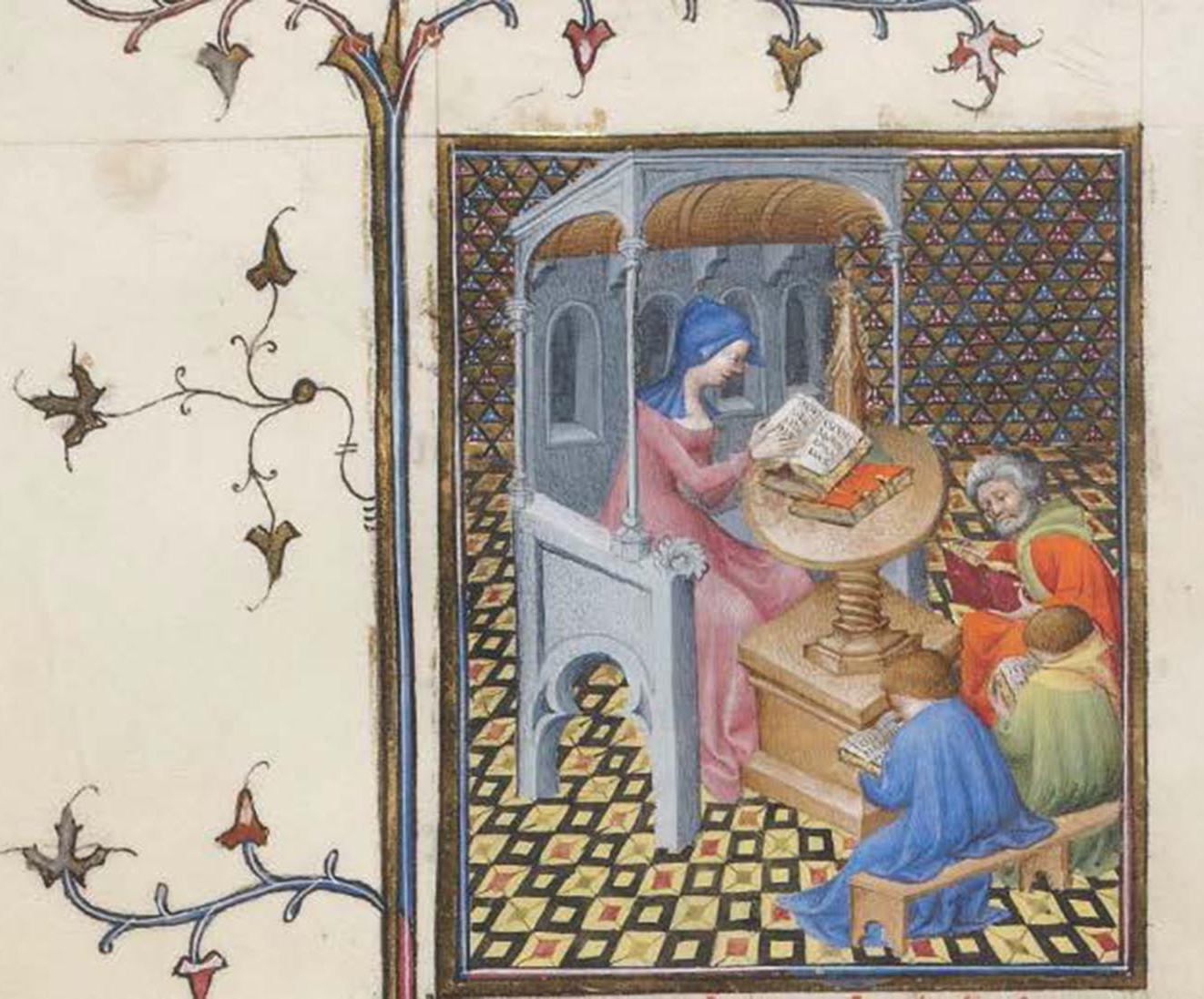
“Sappho Teaching” (1402-03)
The illumination “Sappho Teaching” (1402-03), also by an unknown French illuminator, provides a comparison of French illuminators’ skills from the same period. The skills of the illuminator of “Sappho Teaching” are on par with the best illuminators of the day. Both manuscripts depict a decorative pattern background. Neither artist fully understands perspective, but the “Sappho Teaching” artist is more daring in attempts at perspective. Sappho, seated in an elaborate chair, is teaching three students, an older man and two young boys. This would not be typical since teaching men was men’s work. The imposing chair contains a lectern or a pulpit, and the students are seated on wooden benches. Several books are present. In medieval France a lectern, wooden benches, and books were associated law and literature, and their inclusion associates Sappho with male power. Boccaccio’s identified her as a cleregesse, a teaching cleric. The structure of the chair includes Gothic windows and an arched roof supported by columns, in some aspects resembling a church. It is a unique creation that places Sappho is the world of men.
Sappho (630-570 BCE) was regarded as the 10th muse, notable for her lyric poetry which was to be accompanied by music. Boccaccio describes that “she was born of noble parents, because a degenerate or plebeian mind would not have been able to desire or attain to literary production. And so, even though we do not know when she flourished, she was nevertheless of such a noble mind, blossoming in age and form, not content just to know how to join words together, but burning with a great fire of the mind and the persuasive vivacity of her genius, she ascended the lofty and jutting peak of Parnassus with her untiring zeal and, with a lucky stroke of boldness, joined herself to the Muses.”
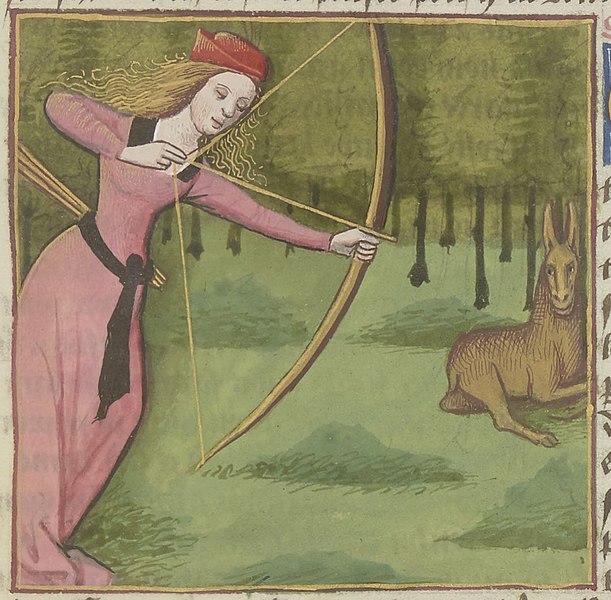
“Zenobia, Queen of Palmyra” (1488-96)
“Zenobia, Queen of Palmyra” (1488-96) is an illumination by French artist Robinet Testard (1470-1531). Boccaccio writes that Zenobia “was so virtuous, according to the testimony of ancient documents, that she must precede all other foreign women in fame. First of all, she was noble in lineage, for they say she was a descendant of the Ptolemies, the rulers of Egypt, although there is no record of her parents. They tell us that from childhood she scorned all womanly exercises, and when she had grown up somewhat and become strong, she dwelt for the most part in forests and woods and, girding on the quiver, pursued and slew goats and stags.”
Testard depicted Zenobia as described by Boccaccio; bow in hand, she is about to shoot a recumbent deer that resembles a long-eared donkey more than a deer.
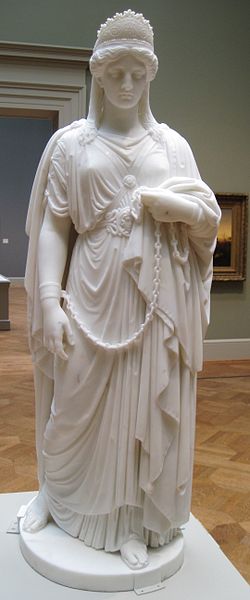
“Zenobia in Chains” (1859)
“Zenobia in Chains” (1859) (44’’x14’’x18’’) (marble) is a work by American sculptor Harriet Hosmer. As Queen of Palmyra, Zenobia was regent from 267 until 272 CE. She opened her court to scholars and philosophers, was tolerant of religious minorities, and she ruled her empire well. She conquered Egypt and much of Asia Minor, but the Roman Emperor Aurelian conquered her empire in 272 CE. Aurelian took her to Rome and paraded her through the streets. Harriet Hosmer (1830-1908) was one of several American women sculptors working in Rome in the 19th Century. Hosmer’s “Zenobia in Chains” was exhibited at the London International Exposition in 1862. Hosmer stated, “I have tried to make her too proud to exhibit passion or emotion of any kind; not subdued, though a prisoner; but calm, grand, and strong within herself.”
Hosmer expressed the sentiment that “Every woman should have the opportunity of cultivating her talents to the fullest extent, for they were not given her for nothing.” The theme for International Woman’s Day in 2024, is “INSPIRE INCLUSION.”
Beverly Hall Smith was a professor of art history for 40 years. Since retiring with her husband Kurt to Chestertown in 2014, she has taught art history classes at WC-ALL. She is also an artist whose work is sometimes in exhibitions at Chestertown RiverArts and she paints sets for the Garfield Center for the Arts.




Write a Letter to the Editor on this Article
We encourage readers to offer their point of view on this article by submitting the following form. Editing is sometimes necessary and is done at the discretion of the editorial staff.